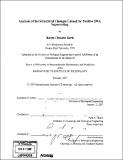| dc.contributor.advisor | Peter C. Dedon. | en_US |
| dc.contributor.author | Barth, Marita Christine | en_US |
| dc.contributor.other | Massachusetts Institute of Technology. Biological Engineering Division. | en_US |
| dc.date.accessioned | 2008-01-10T15:57:14Z | |
| dc.date.available | 2008-01-10T15:57:14Z | |
| dc.date.copyright | 2007 | en_US |
| dc.date.issued | 2007 | en_US |
| dc.identifier.uri | http://hdl.handle.net/1721.1/39907 | |
| dc.description | Thesis (Ph. D.)--Massachusetts Institute of Technology, Biological Engineering Division, 2007. | en_US |
| dc.description | Includes bibliographical references. | en_US |
| dc.description.abstract | The procession of helix-tracking enzymes along a DNA molecule results in the formation of supercoils in the DNA, with positive supercoiling (overwinding) generated ahead of the enzyme, and negative supercoiling (underwinding) in its wake. While the structural and physiological consequences of negative supercoiling have been well studied, technical challenges have prevented extensive examination of positively supercoiled DNA. Studies suggest that at sufficiently high levels of overwinding, DNA relieves strain by adopting an elongated structure, where the bases are positioned extrahelically and the backbones occupy the center of the helix. This transition has only been identified, however, at a degree of supercoiling substantially higher than is generated physiologically. To examine the structural changes resulting from physiological levels of positive DNA supercoiling, I have developed a method for preparing highly purified positively supercoiled plasmid substrates. Based on a method previously developed in this laboratory, this allows for preparation of large quantities of very pure, highly positively supercoiled plasmid. It also expands on earlier methods by exploiting ionic strength to modulate the direction of supercoiling introduced, allowing preparation of either positively or negatively supercoiled substrates. | en_US |
| dc.description.abstract | (cont.) A combination of approaches has been used to elucidate changes to DNA structure that result from physiological levels of positive supercoiling. Enzymatic probes for regions of single-stranded character are not reactive with positively supercoiled plasmid, indicating that stably unpaired regions are not present. Additionally, the effect of supercoiling on the activity of restriction enzymes has been examined. With the enzymes tested, no substantial differences in cleavage rates were observed with either positively or negatively supercoiled substrates. To examine structural changes at a wider range of superhelical densities, design and preparation was undertaken on 2-aminopurine-containing DNA substrates for use in fluorescence studies with a magnetic micromanipulator. Technical limitations rendered these experiments infeasible with current instrumentation, but important insights were gained for future fluorescence-based A destabilizing effect on the base pairs, however, can be seen using Raman difference spectroscopy, suggesting a subtle shift toward the more extreme extrahelical state. | en_US |
| dc.description.abstract | (cont.) The Raman data suggest that structural adjustments due to positive supercoiling are small but significant, and in addition to the base-pairing effects, alterations are observed in phosphodiester torsion and the minor groove environment, as well as a slight shift in sugar pucker conformation to accommodate lengthening of the DNA backbone. These results point to subtle changes in DNA structure caused by biologically relevant levels of positive superhelical tension and positive supercoiling. All of the changes are consistent with the mechanical effects of helical overwinding and suggest a model in which base pair destabilization in overwound DNA could affect the search mechanisms used by DNA repair enzymes and the binding of other proteins to DNA. | en_US |
| dc.description.statementofresponsibility | by Marita Christine Barth. | en_US |
| dc.format.extent | 164 p. | en_US |
| dc.language.iso | eng | en_US |
| dc.publisher | Massachusetts Institute of Technology | en_US |
| dc.rights | MIT theses are protected by copyright. They may be viewed, downloaded, or printed from this source but further reproduction or distribution in any format is prohibited without written permission. | en_US |
| dc.rights.uri | http://dspace.mit.edu/handle/1721.1/7582 | |
| dc.subject | Biological Engineering Division. | en_US |
| dc.title | Analysis of the structural changes caused by positive DNA supercoiling | en_US |
| dc.type | Thesis | en_US |
| dc.description.degree | Ph.D. | en_US |
| dc.contributor.department | Massachusetts Institute of Technology. Department of Biological Engineering | |
| dc.identifier.oclc | 182574514 | en_US |
